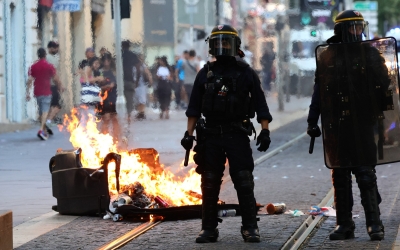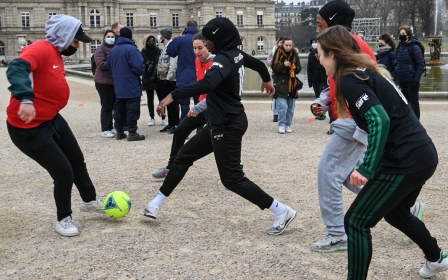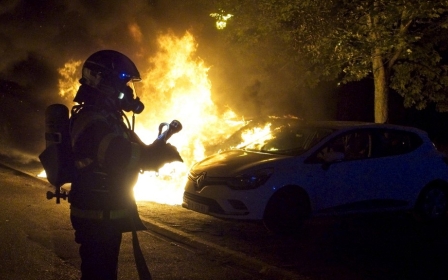France riots: In the banlieues, race and class intersect
It is Tuesday, 27 June, the eve of the Muslim Eid al-Adha celebration. Chilling images are splashed across the pages of French social media.
They show two police officers on the left side of a vehicle that's trying to flee. One of the policemen opens fire. The vehicle stops a few metres further on. Shot in the chest, the driver dies an hour later.
Two people have now been killed, in Nanterre, a suburb of Paris, and Marseille, and a man in Mont-Saint-Martin, in northeastern France, has fallen into a coma.
Despite the frightening toll of police interventions in less than a week, France continues to deny the problem and refuses to open the debate on police and racism.
Even before we know where the scene took place, and without knowing anything about the victim, the ease with which the police officer opened fire indicated that his target was not white.
The intuition shared by many turned out to be correct: the victim of the police shooting was a 17-year-old French teenager of Moroccan and Algerian descent, Nahel Merzouk, a resident of Nanterre, where the incident took place.
Nahel was living in one of the towers of the "Cite Picasso", famous for its 1970s modernist architecture and its "cloud towers".
'Killables'
As soon as the facts became known, the statements "Nahel was killed because of the multiple offences he committed [driving without a licence, refusal to comply]", or even "Nahel was killed because of his origins" have placed the focus almost exclusively on the victim, rendering the actions of the police officer invisible.
The reason the young men were killed was because a particular ideology and practice has decreed them 'killable'
If the aim of these statements is to denounce racism, they actually attribute the tragedy to who the victim is, rather than to what his killer does and believes.
In other words, Nahel did not die for what he is (his origins), but for what the policeman believed and did (a potentially racially-motivated killing). He appears to have died because a police officer felt more invested in his power to take lives than to value all segments of the population.
This power also appeared to authorise another police officer to shoot Mohamed, while the 27-year-old delivery man was filming a police intervention in Marseille (he died a few minutes later), and another policeman to shoot Aimene in Mont-St-Martin, who had a disguised lethal weapon, a "bean bag".
The 25-year-old man, who was returning from a shopping trip, has since been in a coma.
The power conferred to state authorities had already settled in the nation and the police force long before Nahel, Mohamed or Aimene were even born. To use an expression coined by sociologist Abdelmalek Sayad, the reason they were killed was that a particular ideology and practice has decreed them "killable" (Sayad uses the term "assassinable", which implies premeditation).
Nothing to think about
The scenes of looting and urban chaos that followed Nahel's death were deliberately used to obscure the main reasons for the riots: the outrage triggered by yet another incident of police violence and the fear, just as legitimate, that it will be followed by a denial of justice. It is not so much the exceptional nature of the killing that has inspired the recent uprising, but rather, its familiarity.
Dominating mainstream discussions are official condemnations of the riots over any serious examination of the longstanding and immediate causes of the protests - especially police racism, which is deemed nonexistent. And when lip service is paid to its existence, it is reduced to a negligible amount and quickly sanctioned.
In other words, the police brutality that targets certain bodies is relegated to the domain of what does not count as political. The systemic nature of such police violence is denied in favour of a rudimentary explanation that emphasises the perpetrator's individual actions or "free will".
The state and its institutions are no longer culpable. Just move on, there's nothing to think about and nothing to see.
Another way of evading the debate is to overgeneralise the critique: the police institution in its entirety would be unfairly accused of being racist. "Not all police" then becomes a powerful mechanism of denial.
The real question is elsewhere: how was a certain type of "truth" on the dangerousness of certain bodies constructed and transmitted?
'Licence to shoot'
The act that institutes death carries both the heritage of national history (which is also a colonial history) and the power conferred by law and judicial institutions. The question of who ideologically and legally arms the police has distant and recent causes. Among them is the 28 February 2017 law on public security.
Adopted in the context of terrorist attacks, it is Article 1 (now Article L 435-1 of the internal security code), which dramatically expanded the conditions under which the police could use their weapons. Its consequences were immediate: not only were there more shootings of motorists in the context of "refusal to comply", but these shootings were also more deadly.
If that double statistical inflation started as soon as the law was implemented, it has only accelerated since the beginning of 2022. France is thus beating tragic records in Europe with one death every month since January 2022, against only one for the past 10 years in Germany. France's Minister of the Interior may affirm the contrary, but the statistical reality is that the shootings have been more numerous and deadly since the law passed.
The police seem to have been disinhibited by the 2017 law. The principles of self-defence (necessity, proportionality, and immediacy of threat), which until then had governed the use of weapons, seem to have become obsolete, replaced by a sovereign assessment of the police officer, itself largely based on the truth that has been built and circulates on the dangerousness of certain bodies.
Race and class
The killing of Nahel and subsequent riots have taken place 18 years - the age equivalent of a legal adult - after the 2005 riots. A whole generation has grown up since that three-week uprising. Throughout this time, the media and political focus on Islam had pushed the suburbs and the social problems concentrated there into the background.
In short, the dominant security discourse had shifted from suburbanite (what the French call le banlieusard, meaning a resident of an impoverished housing project, the closest France has to the "urban ghettoes") to Islamist.
The dominant security discourse had shifted from suburbanite (race, class) to Islamist (religion, culture)
It is neither a matter of opposing Islamophobia and the "social question" nor of making Islamophobia a diversion. It is rather a question of showing that the social problems which accumulate in certain territories (poverty, unemployment, access to housing and care, racism, urban relegation, education, transportation, etc) had for a time disappeared from the media's radar.
The young rioters bring us back to reality and show us that, since the 2005 riots, these problems have only worsened under the blows of neoliberal policies, the disengagement of the state (except in repressive matters), and general impoverishment. In essence, nothing has been resolved since 2005. The rise of identity discourse is also not unrelated to this situation.
The greatest power of racism seems to be its ability to oversimplify the world. Race, culture and religion are brandished as shallow explanations for complex realities, at the cost of a distressing tautology: populations of immigrant descent are culturally violent because their culture advocates violence.
Racist discourse then takes the form of racialising social issues, which are themselves (ironically) linked to racist discrimination. Poverty and failures in the education system are all social phenomena that have passed through the sieve of racist, uncritical thinking.
On the question of the suburbs, la question des banlieues, the issues of race and class intersect and bind together.
The views expressed in this article belong to the author and do not necessarily reflect the editorial policy of Middle East Eye.
This article is available in French on Middle East Eye French edition.
Middle East Eye propose une couverture et une analyse indépendantes et incomparables du Moyen-Orient, de l’Afrique du Nord et d’autres régions du monde. Pour en savoir plus sur la reprise de ce contenu et les frais qui s’appliquent, veuillez remplir ce formulaire [en anglais]. Pour en savoir plus sur MEE, cliquez ici [en anglais].






